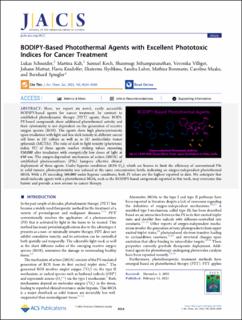Please use this identifier to cite or link to this item:
https://doi.org/10.21256/zhaw-27270Full metadata record
| DC Field | Value | Language |
|---|---|---|
| dc.contributor.author | Schneider, Lukas | - |
| dc.contributor.author | Kalt, Martina | - |
| dc.contributor.author | Koch, Samuel | - |
| dc.contributor.author | Sithamparanathan, Shanmugi | - |
| dc.contributor.author | Villiger, Veronika | - |
| dc.contributor.author | Mattiat, Johann | - |
| dc.contributor.author | Kradolfer, Flavia | - |
| dc.contributor.author | Slyshkina, Ekaterina | - |
| dc.contributor.author | Luber, Sandra | - |
| dc.contributor.author | Bonmarin, Mathias | - |
| dc.contributor.author | Maake, Caroline | - |
| dc.contributor.author | Spingler, Bernhard | - |
| dc.date.accessioned | 2023-03-11T11:41:12Z | - |
| dc.date.available | 2023-03-11T11:41:12Z | - |
| dc.date.issued | 2023-03-01 | - |
| dc.identifier.issn | 0002-7863 | de_CH |
| dc.identifier.issn | 1520-5126 | de_CH |
| dc.identifier.uri | https://digitalcollection.zhaw.ch/handle/11475/27270 | - |
| dc.description.abstract | Here, we report six novel, easily accessible BODIPY-based agents for cancer treatment. In contrast to established photodynamic therapy (PDT) agents, these BODIPY-based compounds show additional photothermal activity and their cytotoxicity is not dependent on the generation of reactive oxygen species (ROS). The agents show high photocytotoxicity upon irradiation with light and low dark toxicity in different cancer cell lines in 2D culture as well as in 3D multicellular tumor spheroids (MCTSs). The ratio of dark to light toxicity (phototoxic index, PI) of these agents reaches striking values exceeding 830,000 after irradiation with energetically low doses of light at 630 nm. The oxygen-dependent mechanism of action (MOA) of established photosensitizers (PSs) hampers effective clinical deployment of these agents. Under hypoxic conditions (0.2% O2), which are known to limit the efficiency of conventional PSs in solid tumors, photocytotoxicity was induced at the same concentration levels, indicating an oxygen-independent photothermal MOA. With a PI exceeding 360,000 under hypoxic conditions, both PI values are the highest reported to date. We anticipate that small molecule agents with a photothermal MOA, such as the BODIPY-based compounds reported in this work, may overcome this barrier and provide a new avenue to cancer therapy. | de_CH |
| dc.language.iso | en | de_CH |
| dc.publisher | American Chemical Society | de_CH |
| dc.relation.ispartof | Journal of the American Chemical Society | de_CH |
| dc.rights | Licence according to publishing contract | de_CH |
| dc.subject.ddc | 540: Chemie | de_CH |
| dc.subject.ddc | 616: Innere Medizin und Krankheiten | de_CH |
| dc.title | BODIPY-based photothermal agents with excellent phototoxic indices for cancer treatment | de_CH |
| dc.type | Beitrag in wissenschaftlicher Zeitschrift | de_CH |
| dcterms.type | Text | de_CH |
| zhaw.departement | School of Engineering | de_CH |
| zhaw.organisationalunit | Institute of Computational Physics (ICP) | de_CH |
| dc.identifier.doi | 10.1021/jacs.2c11650 | de_CH |
| dc.identifier.doi | 10.21256/zhaw-27270 | - |
| dc.identifier.pmid | 36780327 | de_CH |
| zhaw.funding.eu | No | de_CH |
| zhaw.issue | 8 | de_CH |
| zhaw.originated.zhaw | Yes | de_CH |
| zhaw.pages.end | 4544 | de_CH |
| zhaw.pages.start | 4534 | de_CH |
| zhaw.publication.status | publishedVersion | de_CH |
| zhaw.volume | 145 | de_CH |
| zhaw.embargo.end | 2024-02-13 | de_CH |
| zhaw.publication.review | Peer review (Publikation) | de_CH |
| zhaw.webfeed | Sensors and Measuring Systems | de_CH |
| zhaw.author.additional | No | de_CH |
| zhaw.display.portrait | Yes | de_CH |
| Appears in collections: | Publikationen School of Engineering | |
Files in This Item:
| File | Description | Size | Format | |
|---|---|---|---|---|
| 2023_Schneider-etal_BODIPY-based-photothermal-agents-cancer-treatment_JACS.pdf | 5.33 MB | Adobe PDF |  View/Open |
Show simple item record
Schneider, L., Kalt, M., Koch, S., Sithamparanathan, S., Villiger, V., Mattiat, J., Kradolfer, F., Slyshkina, E., Luber, S., Bonmarin, M., Maake, C., & Spingler, B. (2023). BODIPY-based photothermal agents with excellent phototoxic indices for cancer treatment. Journal of the American Chemical Society, 145(8), 4534–4544. https://doi.org/10.1021/jacs.2c11650
Schneider, L. et al. (2023) ‘BODIPY-based photothermal agents with excellent phototoxic indices for cancer treatment’, Journal of the American Chemical Society, 145(8), pp. 4534–4544. Available at: https://doi.org/10.1021/jacs.2c11650.
L. Schneider et al., “BODIPY-based photothermal agents with excellent phototoxic indices for cancer treatment,” Journal of the American Chemical Society, vol. 145, no. 8, pp. 4534–4544, Mar. 2023, doi: 10.1021/jacs.2c11650.
SCHNEIDER, Lukas, Martina KALT, Samuel KOCH, Shanmugi SITHAMPARANATHAN, Veronika VILLIGER, Johann MATTIAT, Flavia KRADOLFER, Ekaterina SLYSHKINA, Sandra LUBER, Mathias BONMARIN, Caroline MAAKE und Bernhard SPINGLER, 2023. BODIPY-based photothermal agents with excellent phototoxic indices for cancer treatment. Journal of the American Chemical Society. 1 März 2023. Bd. 145, Nr. 8, S. 4534–4544. DOI 10.1021/jacs.2c11650
Schneider, Lukas, Martina Kalt, Samuel Koch, Shanmugi Sithamparanathan, Veronika Villiger, Johann Mattiat, Flavia Kradolfer, et al. 2023. “BODIPY-Based Photothermal Agents with Excellent Phototoxic Indices for Cancer Treatment.” Journal of the American Chemical Society 145 (8): 4534–44. https://doi.org/10.1021/jacs.2c11650.
Schneider, Lukas, et al. “BODIPY-Based Photothermal Agents with Excellent Phototoxic Indices for Cancer Treatment.” Journal of the American Chemical Society, vol. 145, no. 8, Mar. 2023, pp. 4534–44, https://doi.org/10.1021/jacs.2c11650.
Items in DSpace are protected by copyright, with all rights reserved, unless otherwise indicated.